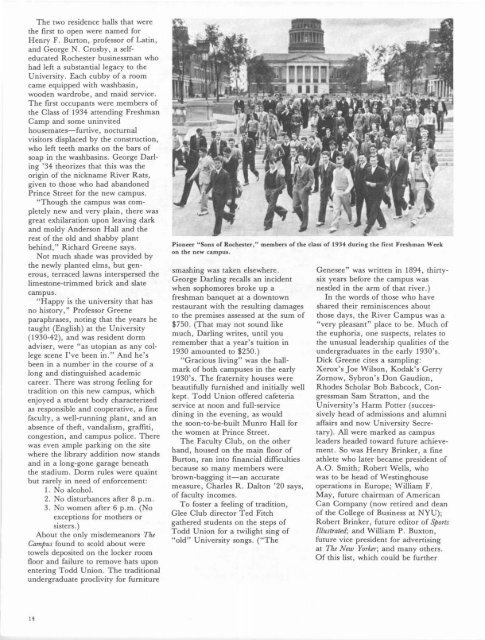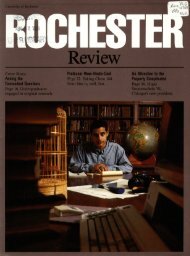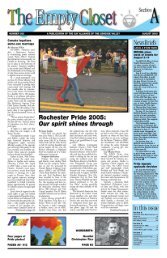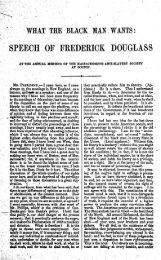Download PDF - University of Rochester Libraries
Download PDF - University of Rochester Libraries
Download PDF - University of Rochester Libraries
Create successful ePaper yourself
Turn your PDF publications into a flip-book with our unique Google optimized e-Paper software.
The two residence halls that were<br />
the first to open were named for<br />
Henry F. Burton, pr<strong>of</strong>essor <strong>of</strong> Latin,<br />
and George N. Crosby, a selfeducated<br />
<strong>Rochester</strong> businessman who<br />
had left a substantial legacy to the<br />
<strong>University</strong>. Each cubby <strong>of</strong> a room<br />
came equipped with washbasin,<br />
wooden wardrobe, and maid service.<br />
The first occupants were members <strong>of</strong><br />
the Class <strong>of</strong> 1934 attending Freshman<br />
Camp and some uninvited<br />
housemates-furtive, nocturnal<br />
visitors displaced by the construction,<br />
who left teeth marks on the bars <strong>of</strong><br />
soap in the washbasins. George Darling<br />
'34 theorizes that this was the<br />
origin <strong>of</strong> the nickname River Rats,<br />
given to those who had abandoned<br />
Prince Street for the new campus.<br />
"Though the campus was completely<br />
new and very plain, there was<br />
great exhilaration upon leaving dark<br />
and moldy Anderson Hall and the<br />
rest <strong>of</strong> the old and shabby plant<br />
behind," Richard Greene says.<br />
Not much shade was provided by<br />
the newly planted elms, but generous,<br />
terraced lawns interspersed the<br />
limestone-trimmed brick and slate<br />
campus.<br />
"Happy is the university that has<br />
no history," Pr<strong>of</strong>essor Greene<br />
paraphrases, noting that the years he<br />
taught (English) at the <strong>University</strong><br />
(1930-42), and was resident dorm<br />
adviser, were "as utopian as any college<br />
scene I've been in." And he's<br />
been in a number in the course <strong>of</strong> a<br />
long and distinguished academic<br />
career. There was strong feeling for<br />
tradition on this new campus, which<br />
enjoyed a student body characterized<br />
as responsible and cooperative, a fine<br />
faculty, a well-running plant, and an<br />
absence <strong>of</strong> theft, vandalism, graffiti,<br />
congestion, and campus police. There<br />
was even ample parking on the site<br />
where the library addition now stands<br />
and in a long-gone garage beneath<br />
the stadium. Dorm rules were quaint<br />
but rarely in need <strong>of</strong> enforcement:<br />
1. No alcohol.<br />
2. No disturbances after 8 p.m.<br />
3. No women after 6 p.m. (No<br />
exceptions for mothers or<br />
sisters.)<br />
About the only misdemeanors The<br />
Campus found to scold about were<br />
towels deposited on the locker room<br />
floor and failure to remove hats upon<br />
entering Todd Union. The traditional<br />
undergraduate proclivity for furniture<br />
Pioneer "Sons <strong>of</strong> <strong>Rochester</strong>," members <strong>of</strong> the class <strong>of</strong> 1934 during the first Freshman Week<br />
on the new campus.<br />
smashing was taken elsewhere.<br />
George Darling recalls an incident<br />
when sophomores broke up a<br />
freshman banquet at a downtown<br />
restaurant with the resulting damages<br />
to the premises assessed at the sum <strong>of</strong><br />
$750. (That may not sound like<br />
much, Darling writes, until you<br />
remember that a year's tuition in<br />
1930 amounted to $250.)<br />
"Gracious living" was the hallmark<br />
<strong>of</strong> both campuses in the early<br />
1930's. The fraternity houses were<br />
beautifully furnished and initially well<br />
kept. Todd Union <strong>of</strong>fered cafeteria<br />
service at noon and full-service<br />
dining in the evening, as would<br />
the soon-to-be-built Munro Hall for<br />
the women at Prince Street.<br />
The Faculty Club, on the other<br />
hand, housed on the main floor <strong>of</strong><br />
Burton, ran into financial difficulties<br />
because so many members were<br />
brown-bagging it-an accurate<br />
measure, Charles R. Dalton '20 says,<br />
<strong>of</strong> faculty incomes.<br />
To foster a feeling <strong>of</strong> tradition,<br />
Glee Club director Ted Fitch<br />
gathered students on the steps <strong>of</strong><br />
Todd Union for a twilight sing <strong>of</strong><br />
"old" <strong>University</strong> songs. ("The<br />
Genesee" was written in 1894, thirtysix<br />
years before the campus was<br />
nestled in the arm <strong>of</strong> that river.)<br />
In the words <strong>of</strong> those who have<br />
shared their reminiscences about<br />
those days, the River Campus was a<br />
"very pleasant" place to be. Much <strong>of</strong><br />
the euphoria, one suspects, relates to<br />
the unusual leadership qualities <strong>of</strong> the<br />
undergraduates in the early 1930's.<br />
Dick Greene cites a sampling:<br />
Xerox's Joe Wilson, Kodak's Gerry<br />
Zornow, Sybron's Don Gaudion,<br />
Rhodes Scholar Bob Babcock, Congressman<br />
Sam Stratton, and the<br />
<strong>University</strong>'s Harm Potter (successively<br />
head <strong>of</strong> admissions and alumni<br />
affairs and now <strong>University</strong> Secretary).<br />
All were marked as campus<br />
leaders headed toward future achievement.<br />
So was Henry Brinker, a fine<br />
athlete who later became president <strong>of</strong><br />
A.O. Smith; Robert Wells, who<br />
was to be head <strong>of</strong> Westinghouse<br />
operations in Europe; William F.<br />
May, future chairman <strong>of</strong> American<br />
Can Company (now retired and dean<br />
<strong>of</strong> the College <strong>of</strong> Business at NYU);<br />
Robert Brinker, future editor <strong>of</strong> Sports<br />
Illustrated; and William P. Buxton,<br />
future vice president for advertising<br />
at The New Yorker; and many others.<br />
Of this list, which could be further
















